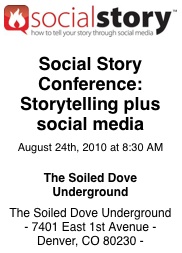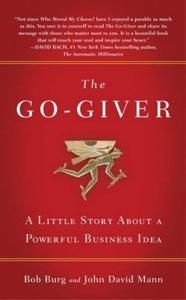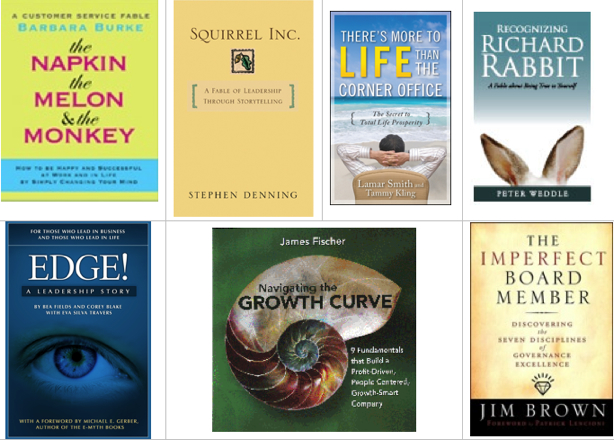 Though I am unlikely to be able to attend, my friend Trey Pennington is putting on a mighty tempting conference later this month. It’s called Social Story: How To Tell Your Story Through Social Media, and another friend, Sean Buvala, will present there. While I suspect that the conference will be oriented toward businesses and solopreneurs, I feel like most of the principles that apply to these groups also apply to individuals and job-seekers who want to tell stories in social media about their personal brands.
Though I am unlikely to be able to attend, my friend Trey Pennington is putting on a mighty tempting conference later this month. It’s called Social Story: How To Tell Your Story Through Social Media, and another friend, Sean Buvala, will present there. While I suspect that the conference will be oriented toward businesses and solopreneurs, I feel like most of the principles that apply to these groups also apply to individuals and job-seekers who want to tell stories in social media about their personal brands.
For example, Trey recently posted an entry on his blog entitled TIP: Use Facebook to tell your “who we are” story by giving fans behind-the-scenes access in which he wrote:
Wondering how to put Facebook to work building connections with prospects and customers? You can use unused photos from your catalog photo shoot to give catalog recipients behind-the-scenes access. When you do, you use the power of social media to help customers experience your “who we are” story for themselves. You make it possible for them to personalize your story and make it their own. Encourage comments. More importantly, ACKNOWLEDGE comments.
So how might we adapt this tip to an individual/job-seeker so that you “use the power of social media to help [employers] experience your “who [I am]” story for themselves? Instead of unused catalog photos, the individual could post photos of being engaged in a workplace project. And the individual can (and should) certainly encourage and acknowledge comments.
A while back, Georgina Laidlaw talked about some of these same principles of storied personal branding in a series highlighting characterization, plot, and narrative.
In the characterization piece, Laidlaw writes:
We all know that there’s a plethora of options for communicating your character though personal branding, including:
- the photos you publish of yourself and others
- your interests, pastimes, and the topics you focus on, including links and other content you promote
- your frequency and depth of public engagement with others
- the places you like to visit or meet others
The other side to the characterization coin is to work out which pieces of information most clearly define the key aspects of your character. Few of us have time to transmit every piece of the minutiae of our days or nights, so we need to choose what we’ll communicate. How do you know what will best illustrate your character to your contacts?
The answer for Laidlaw, she says, is to communicate things you’re passionate about.
Here’s an excerpt from the plot piece:
In a personal branding story, plot is news and events. If each day is an adventure in the story of your life, then each event has the potential to form part of the plot.
Storytellers leave certain aspects out of plot (no one uses the bathroom in a movie, for example, unless something crucial to the storyline happens in there). They do this because some events are irrelevant to the story they’re telling. Those events waste time and distract the audience from the critical pieces of the story.
So for you as an individual trying to build a personal brand, your plotline is your news: what happens every day, and what it means to you. If you have multiple plotlines (reflecting different facets of your life), those events may have a range of impacts on your life. Which parts you choose to communicate, and the ways in which you communicate them, is up to you as the storyteller.
And from the narrative piece:
…[N]arrative is the way you tell stories. It’s the glue that ties your characters to the plot events in your story. As well as elements like scene setting, narrative includes description, so we’ll deal with these aspects together.
You are the key narrator in your own personal branding story, though other characters may have a part in narrating from time to time (for example, a guest blogger narrates part of your brand story while you’re on vacation, or away at a conference).
Since you’re the narrator, the way you tell your story will be driven largely by your character. The channels you choose, and how effectively you use them to narrate your story, will also depend on your character.
While I have a bit of difficulty — in practice — in distinguishing the difference between Laidlaw’s plot and narrative concepts, I find this series an excellent treatment bringing together storytelling, social media, and personal branding.
I’ll be interested to learn the extent to which the Social Story conference views these concepts the same way Laidlaw does. I hope participants produce some meaty writeups for those of us who can’t attend.
In the days leading up to Trey’s and Sean’s conference, I’ll be posting more about this topic.








